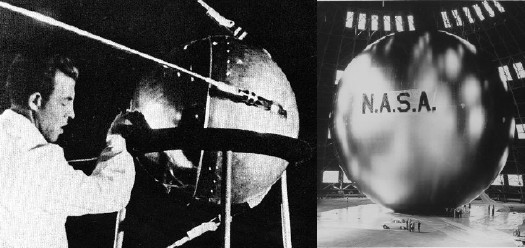
I’ve been searching for historical and primary source material for Project Echo, one of NASA’s earliest missions, which kicked into high gear in 1958. The giant, inflatable satelloons were functional–passive reflection communication satellites. That they were shaped just like Sputnik, only a hundred thousand times bigger, and were visible to the entire world with the naked eye, were, I’m sure, just a happy Space Race coincidence.
Echo I [above, right] was 100 feet in diameter and launched in 1960. Echo II was 135 feet, and launched in 1964. By then engineers at NASA’s Langley Research Center figured out that over-stressing the aluminized Mylar would help the giant sphere keep its shape, even if it deflated a little bit. [Echo I was found to have partially caved in a few months after launch.]
Film and TV cameras were included in the Echo II rocket–the film canisters were recovered in the ocean, but I haven’t found images from the footage. Video of the Echo II Inflation, however, is right here. Retired Goddard engineer Ron Muller screened it as part of a history of The Echo Project at a 2004 NASA conference on solar sails. It’s pretty awesome, right down to the end. [The avi is available for download at the conference page.]
I put a little film strip together after the jump, too:

